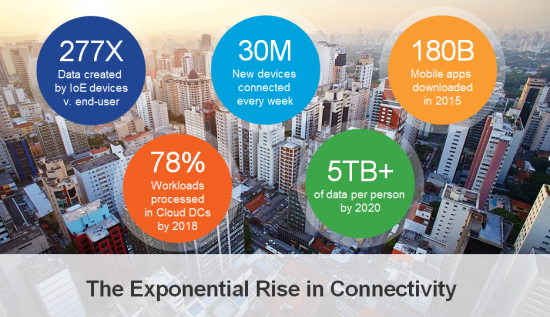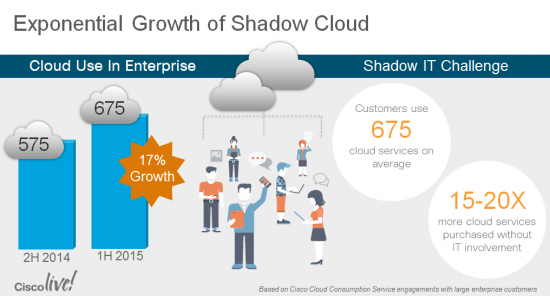































Today at Cisco Live we announced an expansion of our Intercloud strategy. We added new features and capabilities for our hybrid cloud software, Cisco Intercloud Fabric, along with the addition of 35 independent software vendors committed to developing Intercloud-enabled services for customers. Together these developments will give customers more choice, compliance and control in the hybrid cloud world.
But there is a bigger opportunity that goes beyond hybrid cloud. We're not just developing a new cloud platform and connecting the world of many clouds. We're preparing for a much larger hybrid IT-enabled future where billions of digital services, applications and intelligent devices will need a control point. We believe that control point is our Intercloud platform.
The next wave of the Internet
Every hour 300,000 new things connect to the Internet; translating into more than 50 million things a week. And this rate of connectivity is increasing. We estimate that by 2020, 50 billion things and five billion people will be connected.

Each thing will be connected to the Internet. It isn't necessary for everything to have onboard intelligence, or to be connected full time to the Internet. Intelligence and engagement can be abstracted away from the things themselves to the clouds. We can already see this today. Many of us have several cloud connected things already in our own home -the home thermostat, smoke detector, file backup and smart phone to name a few. And it's not just in the home -the explosion includes cloud connected cars like the Tesla and connected smart cities.
This isn't just technology for technology's sake. Connected things are up to ten times more valuable than unconnected things. Take Nest, for example: A basic thermostat retails for$23.19 in the US. But put a cloud connection on it to enable user interaction, device management and basic analytics and Nest can sell it for$249. Similarly, a basic Qwikset door lock sells for$18. But connect it to a cloud so you can open your front door with your Kevo smart phone app and it can sell for$199.

We're seeing a hyper explosion of applications, data and things to the edge of the network. By taking advantage of all of this new data, companies can digitize their business processes and realize$19 trillion in value by 2020. (If you're interested we have a detailed breakdown of our research here.)
Shadow IT Runs Rampant
Companies are catching on quickly but, more often than not, in a very fragmented and risky way. A year ago it was not unusual for our cloud consumption analysis services to find 5 to 7 times more cloud sites being used to store critical company data than the CIOs of our clients were aware of or had authorized. Today, just 12 months later, that number is often 15 to 20 times more and growing. On average, our large enterprise clients are using 675 external cloud services, all of which are storing data and enabling core business processes, especially customer facing ones. The scary part for a CIO: the number of cloud services has increased by 17% over the last six months.

This is creating huge, but often invisible, risks for companies. The primary threat is security -only a small percentage of sites are encrypting data or require stringent access authentication. Recent security scares have created more regulation for companies around compliance and risk mitigation. From the CEO's point of view, the CIO and CSO are responsible for protecting the company and ensuring compliance and policy adherence. But as 50 times more things get connected to the network, the number of clouds and the percentage of their data that is held outside their control will continue to grow. You can't control what you can't see or manage, so they are falling further behind each day that passes in their ability to control all of IT. Compliance audits will regularly be failed.
So far the answer has been hybrid cloud-a combination of public and private clouds. But public cloud economics and interoperability are not a core design principle. As a result we have seen a race to zero in pricing to the point that IaaS is essentially free. Many of the smaller players will be acquired or go out of business as they struggle to fund the CapEx required. Once again this means significant and growing risk for our customers especially as they don't know which clouds are holding their data.
Hybrid IT Trumps Hybrid Cloud
As disruptors, the major public cloud companies have focused on cloud native application enablement not legacy application interoperability. Cloud native apps are cheap to develop, massively scalable, and key enablers in the digitization of business processes in a mobile-centric world. We've all witnessed the disruptive innovation being driven by Uber, Spotify, Airbnb and Stripe. They are different to legacy apps in that they are modular, designed for the mobile-cloud era, built around DevOps principles and utilize some of the technologies like OpenStack and Docker spawned by open source communities.
But from a CIO's perspective, 90% of today's business still runs on legacy apps and will for some time. The result is a growing bifurcation of IT -Gartner calls it "Bimodal IT" -where CIOs are struggling to embrace traditional and agile IT modes in a seamless secure, compliant model with full control.
All of these data points and many more reinforce our belief that a significant swing to a new secure hybrid IT (not just hybrid cloud) model is needed. We have designed Intercloud from scratch with these trends in mind. It's built for the world of many clouds and connects all the clouds, regardless of technology in a way that gives control back to the IT department. It gives the CIO freedom to access whatever cloud services they want in a secure, compliant and friction-free way.
Applications can run on any architecture and use any hypervisor. They can run on the private cloud, in a public cloud and in a partner cloud. They can also run at the edge of the network or even in the home. To address the security concerns, Cisco Intercloud Fabric and Cisco Application Centric Infrastructure (ACI) handle the automation of all application policies across all the clouds meaning that you can trust the integrity of the ecosystem. Furthermore applications can be moved between the clouds in seconds. Essentially it gives the CIO control back in a world of technology fragmentation that is working against them.
That's why more than 60 major cloud providers have already signed up to join the global Intercloud ecosystem and Intercloud-enable more than 350 data centers in over 50 countries. And today, with the addition of 35 new application partners joining the Intercloud ecosystem, we are tapping into the developers who can help customers deploy their cloud native applications more securely.
I'm proud of the momentum we have achieved in just over a year. We're moving quickly to build the foundation of partners, technology and services to bring this audacious vision to life. And best of all -we are just getting started.
 Tags quentes :
Internet of Everything (IOE)
Grande volume de dados
InterCloud
cloud services
Cisco Intercloud Fabric
Tags quentes :
Internet of Everything (IOE)
Grande volume de dados
InterCloud
cloud services
Cisco Intercloud Fabric